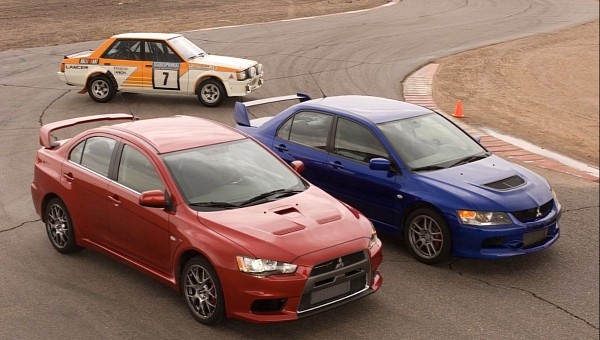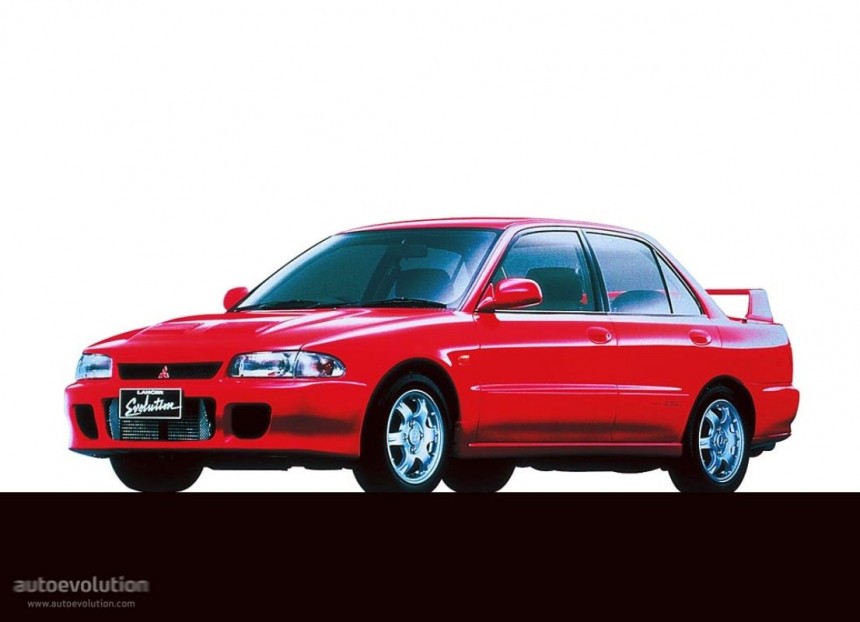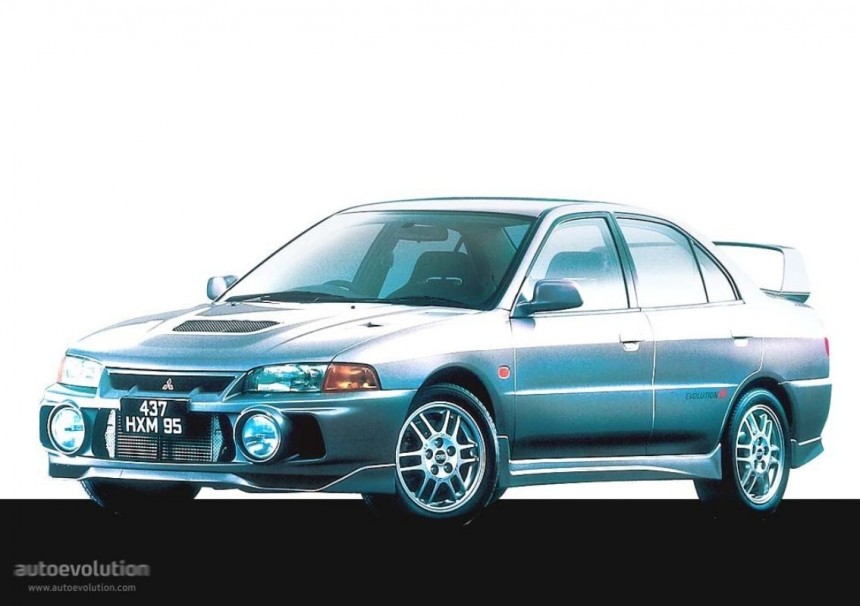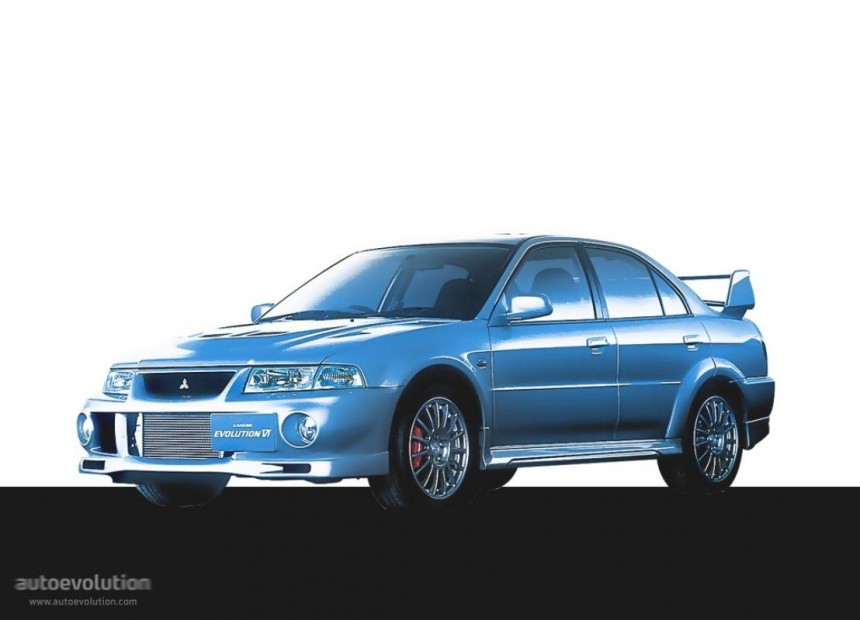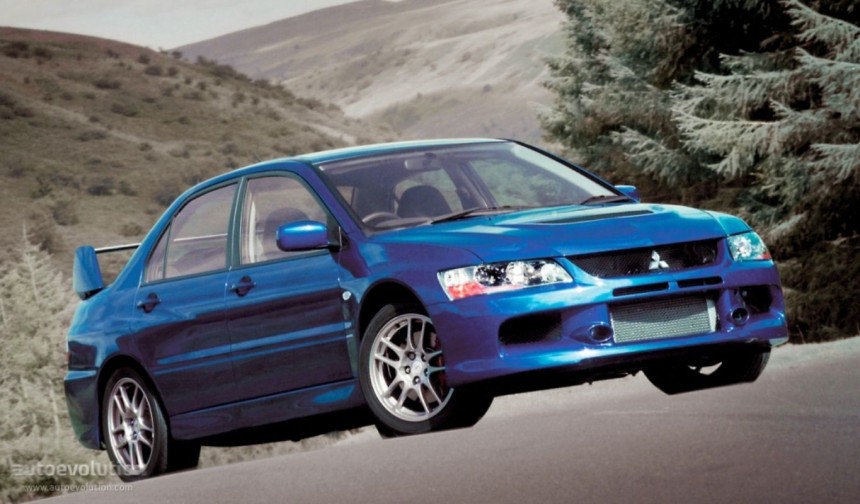The Lancer Evolution was a Mitsubishi rally superstar with an aggressive body style, a potent engine, and an all-wheel drive system. As a result, it acquired a large fan base throughout all ten models, so now, we will take you on a tour of the history of one of the most legendary models in the automotive industry.
The Mitsubishi Lancer Evolution is a Japanese brand's flagship performance car. It's based on the Lancer model, which dates back to 1973. This name was used with other models in the late 1980s and early 1990s for different and various regions where it was sold. However, the fourth-generation Lancer got the first Evolution version in 1992, and the Evo was most famous for its earlier 1990s involvement in the WRC (World Rally Championship) Group A class. In this category, the homologation procedure required that at least 2,500 production units be built to qualify.
The Japanese brand used the larger Galant model for rally competitions in the 1980s and 1990s. The vehicle was quite successful, but in the end, the officials from Mitsubishi decided to move to a smaller and lighter platform to be even more competitive. The Evo capabilities applied to rally and transferred over to the street make these cars favorable for car enthusiasts.
The first Mitsubishi Lancer Evolution appeared in 1992, being designed specifically to compete in the WRC and Asia-Pacific Rally Championship. Before that, the last Lancer model to be involved in WRC was the EX 2000 Turbo, ten years before. The engineers from Mitsubishi transferred the engine and drivetrain from the larger Galant VR4 to the smaller Lancer chassis. It was sold in two versions, the GSR, which was more of a street car, and a stripped-down RS which was more race focused and lighter.
This generation started the Evolution trademark with a turbocharged four-cylinder engine with an all-wheel drive system and five-speed manual transmission. As a result, the limited 2,500 units required for the FIA homologation were sold out within three days, and Mitsubishi made another 2,500 to meet the increased demand.
Their involvement in the 1993 WRC had them close to several victories. This was an accomplishment in itself since it was only the first year, and they were working with a new chassis. All it was needed was just a little more development. Just over a year later, the second generation of the Lancer Evolution arrived, receiving new updates to the suspension and chassis from the rally experience gained with the first Evo to make it more competitive and hopefully challenge for a title in the rally.
Visually, there were not many differences from the previous model, but the handling was improved. It still used the same engine and all-wheel drive combination but received a power increase. The Japanese automaker's production experience from the first Evo made them create 5,000 Evo II models, which sold out in four months. In addition, the car won the 1995 WRC Swedish rally, providing more motivation for improvement. The same year they won in Sweden, they introduced the Evolution III, which had a new functional look. Still, many people consider this as a second-generation Evolution since it used the previous C98 chassis. The speeds were increasing for rally stages, so Mitsubishi installed a new turbocharger that increased the power to 270 hp (274 PS) and the torque to 228 lb-ft (309 Nm).
It sold 7,000 units and was the best-selling Evo compared to the previous ones. Mitsubishi finally received its first WRC driver's title in 1996 with the help of legendary driver Tommi Makinen. Their efforts paid off when they also won the manufacturer's championship for the Asia-Pacific Rally Championship.
In the same year, the Lancer Evo IV was introduced. This was a totally new car. It received many improvements, with the biggest one being the available active rear differential. Furthermore, the vehicle used sensors to distribute torque between the wheels. In addition, this was also the first introduction of a revised 4G63T engine, which was placed 180 degrees from its predecessor, improving the weight distribution and canceling the torque steer.
With all those new stuff, the Evolution did get heavier, but the engine got more responsive thanks to the new twin-scroll turbocharger. At the same time, this was the first model to have large rally-inspired front fog lights. Technology, starting with this generation, was beginning to get favored more. Tommi Makinen continued winning the WRC championship in 1997 as well. As a result, the Mitsubishi Lancer Evolution's popularity exploded at this time.
The Evo V received new styling and aerodynamic elements, the model being revised for better cooling and a more aggressive look. An adjustable aluminum rear wing was also standard, as well as 17-inch wheels to accommodate larger brakes. Also, there were weight reduction components, technology improvements, and interior refinements. The declared power remained the same at 276 hp (280 PS) because of the gentlemen's agreement between them and other Japanese automakers. Still, the new turbocharger did help increase torque.
This fifth Lancer Evolution was built according to the new WRC rules. They were still using a production model car while other manufacturers moved on to WRC-specific and special chassis. Despite all the factors going against them, Mitsubishi won its first WRC manufacturer's title in 1998, and the same Tommi Makinen won the driver's title again in 1998 and 1999. At that time, Tommi Makinen was the most successful rally driver in history and a very famous name in the motorsport world.
The Lancer Evolution VI was still based on the fourth-generation chassis. They can be distinguished by the double rear wing and the smaller front fog lights. The revisions were again more mechanical, being focused on durability, cooling, engine, and other parts. While it may not have been faster than its predecessor, slight changes have been felt while driving. It was the last Evo created by using the old Group A homologation rules. WRC requirements favored specific cars, so Mitsubishi decided that this was the last we see of Lancer Evo production in the World Rally Championship. As I said earlier, Tommi Makinen was a living legend in the world of motorsport, winning four straight championships with Mitsubishi. As a result, the Japanese automaker created a unique Tommi Makinen edition Evolution produced in a limited quantity of 2,000 units to celebrate his accomplishments. Due to some slight upgrades, most enthusiasts refer to it as the Evo 6.5.
The Lancer Evolution VII was based on the much larger Lancer Cedia. The larger size made it equivalent to the Galant, which they decided to get away from some years before for rally purposes. The chassis received stiffening, which added some weight over the previous Lancer Evo. Still, a torque increase helped with the added weight. The active center differential was introduced and combined with the dynamic yaw control making the car more responsive. The model with the larger, stiffer chassis and technology became more civilized on the road. Mitsubishi pursued the WRC with their first rally-specific Evo VII in 2001. However, they were not as successful as hoped for, and with Tommi Makinen leaving to drive for Subaru for the 2002 season, the driver lineup and development of the WRC spec Evo were in question. Besides all the competition stuff, the Evo VII was also featured in the movie 2 Fast 2 Furious.
The Lancer Evo VIII was introduced in 2003 and was the first Evolution sold in the United States. This effect was caused by Subaru's success with their WRX a year earlier. The eighth model came with a multitude of technologies that were dependent on the market being sold. The Evo received much praise from car journalists and magazines in the USA. Besides, it had that classic rivalry with the Subaru WRX STI that came out in the same year.
Two years later, in 2005, the automaker offered the MR edition for specific markets. It featured various upgrades that included suspension tweaks, an aluminum roof, BBS wheels, and a six-speed manual. Until this point, the Evo came with only a five-gears transmission. The Japanese automaker decided to take a year off in 2003 from WRC and returned in 2004. However, they pulled out once again before the 2006 season.
The Mitsubishi Lancer Evolution IX was introduced in 2005, still using the seventh-generation chassis. It shared a lot with the previous Evo model but, at the same time, received substantial changes to the front and rear. Mitsubishi's MIVEC variable timing control system was introduced on the intake side of the engine. This method increased power to 287 hp (291 PS) and torque to 289 lb-ft (392 Nm). In addition, the ninth model introduced a 5,500 rpm launch control feature to protect the drivetrain. Once again, an MR version was offered, and a particular wagon version was sold outside the USA in a limited number of 2500.
The last Evolution was the Evo X, which appeared in 2007. This model used a new chassis but was larger, heavier, more refined, and lost the responsiveness of previous generations. Besides, it also received a new aluminum engine, and now the clients could choose between a five-speed manual and a six-speed twin-clutch transmission. With no more rallying involvement to draw interest, plus a loss in its performance edge, high cost, and decreasing sales, the Lancer Evolution series met its end in 2015 with a special Evo X Final Edition. The Final Edition was created to farewell this legendary series that made so many enthusiasts fall in love with cars.
This was the story of the Mitsubishi Lancer Evolution series, and it's very unfortunate that it was discontinued. I was always a fan of any Evo model, and I hope a new Evolution model will be released one day. It might be electric or, at least, electrified. If any.
The Japanese brand used the larger Galant model for rally competitions in the 1980s and 1990s. The vehicle was quite successful, but in the end, the officials from Mitsubishi decided to move to a smaller and lighter platform to be even more competitive. The Evo capabilities applied to rally and transferred over to the street make these cars favorable for car enthusiasts.
The first Mitsubishi Lancer Evolution appeared in 1992, being designed specifically to compete in the WRC and Asia-Pacific Rally Championship. Before that, the last Lancer model to be involved in WRC was the EX 2000 Turbo, ten years before. The engineers from Mitsubishi transferred the engine and drivetrain from the larger Galant VR4 to the smaller Lancer chassis. It was sold in two versions, the GSR, which was more of a street car, and a stripped-down RS which was more race focused and lighter.
This generation started the Evolution trademark with a turbocharged four-cylinder engine with an all-wheel drive system and five-speed manual transmission. As a result, the limited 2,500 units required for the FIA homologation were sold out within three days, and Mitsubishi made another 2,500 to meet the increased demand.
Visually, there were not many differences from the previous model, but the handling was improved. It still used the same engine and all-wheel drive combination but received a power increase. The Japanese automaker's production experience from the first Evo made them create 5,000 Evo II models, which sold out in four months. In addition, the car won the 1995 WRC Swedish rally, providing more motivation for improvement. The same year they won in Sweden, they introduced the Evolution III, which had a new functional look. Still, many people consider this as a second-generation Evolution since it used the previous C98 chassis. The speeds were increasing for rally stages, so Mitsubishi installed a new turbocharger that increased the power to 270 hp (274 PS) and the torque to 228 lb-ft (309 Nm).
It sold 7,000 units and was the best-selling Evo compared to the previous ones. Mitsubishi finally received its first WRC driver's title in 1996 with the help of legendary driver Tommi Makinen. Their efforts paid off when they also won the manufacturer's championship for the Asia-Pacific Rally Championship.
In the same year, the Lancer Evo IV was introduced. This was a totally new car. It received many improvements, with the biggest one being the available active rear differential. Furthermore, the vehicle used sensors to distribute torque between the wheels. In addition, this was also the first introduction of a revised 4G63T engine, which was placed 180 degrees from its predecessor, improving the weight distribution and canceling the torque steer.
The Evo V received new styling and aerodynamic elements, the model being revised for better cooling and a more aggressive look. An adjustable aluminum rear wing was also standard, as well as 17-inch wheels to accommodate larger brakes. Also, there were weight reduction components, technology improvements, and interior refinements. The declared power remained the same at 276 hp (280 PS) because of the gentlemen's agreement between them and other Japanese automakers. Still, the new turbocharger did help increase torque.
This fifth Lancer Evolution was built according to the new WRC rules. They were still using a production model car while other manufacturers moved on to WRC-specific and special chassis. Despite all the factors going against them, Mitsubishi won its first WRC manufacturer's title in 1998, and the same Tommi Makinen won the driver's title again in 1998 and 1999. At that time, Tommi Makinen was the most successful rally driver in history and a very famous name in the motorsport world.
The Lancer Evolution VI was still based on the fourth-generation chassis. They can be distinguished by the double rear wing and the smaller front fog lights. The revisions were again more mechanical, being focused on durability, cooling, engine, and other parts. While it may not have been faster than its predecessor, slight changes have been felt while driving. It was the last Evo created by using the old Group A homologation rules. WRC requirements favored specific cars, so Mitsubishi decided that this was the last we see of Lancer Evo production in the World Rally Championship. As I said earlier, Tommi Makinen was a living legend in the world of motorsport, winning four straight championships with Mitsubishi. As a result, the Japanese automaker created a unique Tommi Makinen edition Evolution produced in a limited quantity of 2,000 units to celebrate his accomplishments. Due to some slight upgrades, most enthusiasts refer to it as the Evo 6.5.
The Lancer Evo VIII was introduced in 2003 and was the first Evolution sold in the United States. This effect was caused by Subaru's success with their WRX a year earlier. The eighth model came with a multitude of technologies that were dependent on the market being sold. The Evo received much praise from car journalists and magazines in the USA. Besides, it had that classic rivalry with the Subaru WRX STI that came out in the same year.
Two years later, in 2005, the automaker offered the MR edition for specific markets. It featured various upgrades that included suspension tweaks, an aluminum roof, BBS wheels, and a six-speed manual. Until this point, the Evo came with only a five-gears transmission. The Japanese automaker decided to take a year off in 2003 from WRC and returned in 2004. However, they pulled out once again before the 2006 season.
The Mitsubishi Lancer Evolution IX was introduced in 2005, still using the seventh-generation chassis. It shared a lot with the previous Evo model but, at the same time, received substantial changes to the front and rear. Mitsubishi's MIVEC variable timing control system was introduced on the intake side of the engine. This method increased power to 287 hp (291 PS) and torque to 289 lb-ft (392 Nm). In addition, the ninth model introduced a 5,500 rpm launch control feature to protect the drivetrain. Once again, an MR version was offered, and a particular wagon version was sold outside the USA in a limited number of 2500.
This was the story of the Mitsubishi Lancer Evolution series, and it's very unfortunate that it was discontinued. I was always a fan of any Evo model, and I hope a new Evolution model will be released one day. It might be electric or, at least, electrified. If any.
